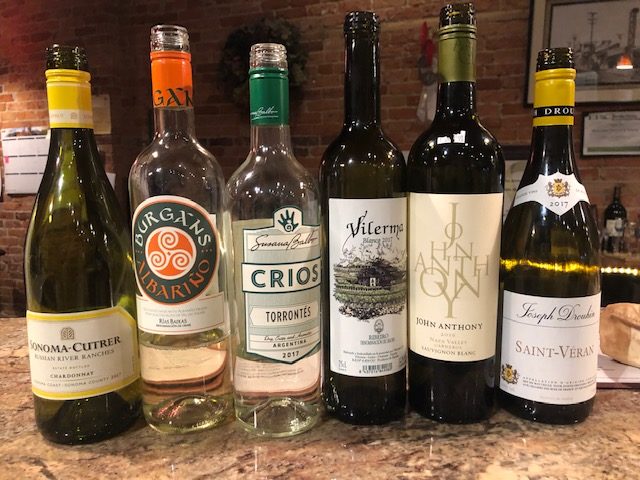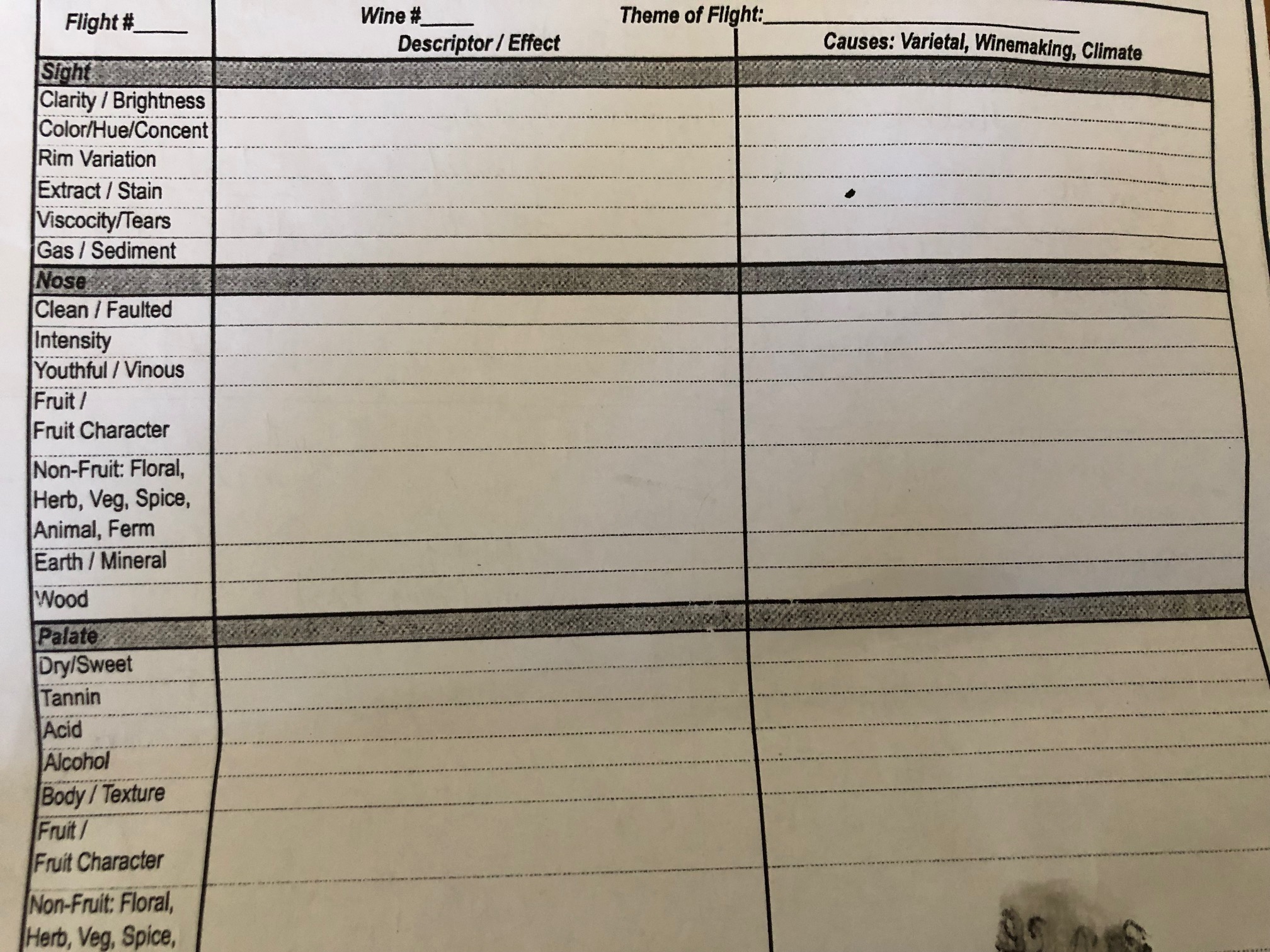I have written about my blind tasting group before. We meet once a month, in Grass Valley, CA. Some of the players have changed—on this particular night we were six: three restaurant people, one winemaker, one winery manager, and me, a writer—but the game remains the same. You pour the wine into a clear glass. A four-minute timer is set. You look at the wine, you smell the wine, you taste the wine. You go around the table in order and discuss various elements of the wine, related to various sensory observations, which, during those four minutes, you have responded to according to the categories provided for you on this sheet, courtesy of the Court of Master Sommeliers, which is called THE GRID, and which you can see at the top of this piece.
You say what kind of wine it could possibly be (chardonnay or pinot grigio or etc.) where it is from (France or Germany or etc.) and when it was made (1-2 years ago, 3-5, etc.) then you try to narrow that down (Burgundy) and exactly when (2016). On this particular warm fragrant April evening we were doing “classic whites.” That means varieties a casual wine drinker has heard of more or less, from regions he has heard of, more or less. There will be some exceptions.
There are blind tasters who can actually guess vintages and specific producers, like “This is a 1998 Jean-Louis Chave Hermitage Blanc.” We are generally not those people, though there are some in my group who know more than others. I say this not with derision; everyone who comes basically knows what they are doing and if they don’t they fake it until they do, and I was once (and often still am) this person. Anyway, Jack knows a lot. Extremely Quiet Guy knows a fair amount. I am somewhat less knowledgeable than Extremely Quiet Guy. Bob, Fairly New Woman and New Guy are all just getting the lay of the land.
Wine #1
I’m going to tell you right now I have trouble approaching my chart in a “rational” way. This is partly because I am an intuitive taster, partly because I have trouble following directions, and partly because I am such an amateur that clues as to what a wine is don’t serve me as well as my instincts. Meaning, if I could approach what makes each wine what it is in a way that was more systematic than “It just smelled Italian to me, dusty but also good,” I would be more organized in my approach. One day!
From the very first sniff I knew this was a California chardonnay. The color was yellowy golden, and I felt as if I’d buried my nose in butterscotch-coated popcorn. Then I tasted it. It seemed extremely familiar. Last year I finally admitted to myself I like a very cold California chardonnay. I totally get why people think they are gross, but I like some of them. I find them comforting and cozy. I do not feel the same about shitty red wine.
After the buzzer went off we went around the circle. People said stuff like “oaky.” Bob said “banana” and “toasty” – all chardonnay things. I went fifth, which meant I was the one beginning the actual guessing process. I wanted to say “this is a chardonnay from Sonoma,” but the pre-conclusion person isn’t supposed to get that specific, so I said “This is a 2-3 year old chardonnay from a medium climate, New World.” (New World means everything but Europe.)
The Final Conculsion guy, Jack, who I know well enough to make fun of and actually has a level one certification in wine tasting, and makes wine, and just knows way way more than I do, which is great because I think of him as a library I have on speed dial, thought it was from France.
“How does it feel to be wrong?” I asked.
“We’ll see about that,” Jack said.
“Indeed we will,” I said.
“Why do you think it’s from California?” asked Fairly New Woman.
“Because I know this wine, I think I drink it all the time,” I said. “I sadly do not drink chardonnays from France all the time.”
“I think it’s too restrained for California,” said Jack.
I said generally Jack was right but not at this time, sadly.
Wine #2
This wine was very light, straw-colored, we say. I wrote down “minty lemon,” feeling that I may have made up the mint part. I was so sure it was a New Zealand sauvignon blanc that I just started to space out. I do that a lot. I get an idea of what something is, convince myself I’m right, and then just can’t seem to consider any other options. It’s weird because I am so often wrong you’d think I’d have stopped this by now. But no. Extremely Quiet Guy said it was an albariño. “I seriously doubt that,” I said. “Albariños aren’t this aromatic.” As I spoke, I was like, shut up, Sarah, you’re an idiot, but the stakes were low.
Wine #3
Even though I thought that I was right about wine #2, I also was pretty sure I was wrong. Does that make sense? With wine #3 I took one sniff, and wrote down “Jean Naté Jean Naté Jean Naté, what wine tastes like Jean Naté?” Then instead of doing literally anything else for the rest of the four minutes I racked my brain trying to remember what wine smells like Jean Naté. I knew it was from Argentina, because it’s only from there but I couldn’t remember the name. But then I did! Torrontés. Torrontés! I just sat there until we were done. You can read more about torrontés, if you wish, however, I will simply quote Jack quoting someone else and say torrontés smells and tastes a bit like Aqua Net, but is good. The New Guy said he’d worked in an Argentine restaurant for a long time and he thought it was torrontés too. I said yes, if it wasn’t torrontés I would quit blind tasting forever. New Guy laughed, he does not know enough yet not to encourage me like this.
Wine #4
This wine smelled and tasted like school grilled cheese. This was my big hit tasting note of the night. I had no idea what it was. Literally zero idea. “This wine is so oily,” Jack said, and then everyone, except for Extremely Quiet Guy, who is nice, and New Guy, who is New, kind of made fun of him for saying it was oily, even though it was. I did my basic notes perfunctorily and then wrote “school grilled cheese” 10 times then wrote “No idea no idea no idea.”
Wine #5
I couldn’t believe how sweet-tasting the wine was. I wrote down “swimming pool with sugar in it.” I wrote down “tasty in spite of itself.” Bob had the big tasting note coup with “green Jolly Rancher.” That said, green Jolly Rancher is a not a wholly uncommon tasting note. I did not really know where this wine came from. Bob thought Washington State. I thought it was probably a Riesling, and New Guy said it could be a Gewürztraminer, and it could have been either of those things, but really, we had no idea. I told New Guy a story about how I went to the restaurant he owned once, after yelling at someone I didn’t like and of whom I had previously been terrified, and had a dozen oysters and two glasses of sauvignon blanc and felt really satisfied with life. I think he was pleased to have provided me with this experience.
Wine #6
What is there to say about Wine #6 , except that it was definitely a chardonnay, in most of our opinions, and that everyone thought it was from California, except for me, who was positive it was from France?

Wine #1
I was right, Jack was wrong. Also, Sonoma Cutrer is the chardonnay they serve at the Terminal A bar at the Sacramento Airport. We have met!
Wine #2
It was an albariño, from Rias Biaxas, in Northern Spain. Also, I knew I was wrong, as I said, but I had kind of thought maybe I wasn’t. Also, I really like albariños, and would say I “prefer them to sauvignon blancs,” yet I mistake them for each other all the time. Aren’t people fascinating?
Wine #3
Torrontés. As promised.
Wine #4
This was actually a blend that the Fairly New Woman brought by mistake. No one was supposed to bring blends tonight. She kept apologizing but no one minded.
Wine #5
Ok, this is the wine I brought and it was A FUCKING SAUVIGNON BLANC and it tasted LIKE A FUCKING MILKSHAKE. Sauvignon blancs are supposed to be dry and herbaceous. I was furious, and felt that I had been trolled by the wine store owner who told me to buy it. Jack and I were furious about the wine’s varietal incorrectness and complained about it for a long time. Bob and New Guy admitted that we were probably right but also said they could probably sell the shit out of an overly sweet sauvignon blanc, especially by the glass.
Fairly Newish Woman didn’t think this wine was so bad and we tried to explain to her why it was but probably failed.
In lieu of stating my feelings about varietal correctness and then later wishing I’d done a better job I DMed New York Times wine writer and all around nice person Eric Asimov, because I was pretty sure he already had a pithy response at the ready.
I would say that on the one hand, varietal correctness is a source of comfort to consumers who will have a fairly good idea of what they are getting. But pursuing varietal correctness can also produce a sort of tyranny, in which all wines made from the same grape, no matter where they come from, would be expected to taste the same. Some of the best wines depart from the norm and sometimes face the wrath of bureaucrats who judge them not to be correct. In conclusion, if I’m not already longwinded enough, I would say that I appreciate varietal correctness in many wines, but I appreciate even more those wines that depart from the norm for the best reasons, like showing a particular terroir in new and different ways.
Residual sugar in a moderately priced SB does not sound like one of those wines. They can also depart from the norm for cynical reasons, which I don’t appreciate.
Exactly.
Wine #6
What is there to say about this wine except that I was right? France. I can smell France. I am not that good at this but I mostly really can. Smell. France.
I got three out of six.







